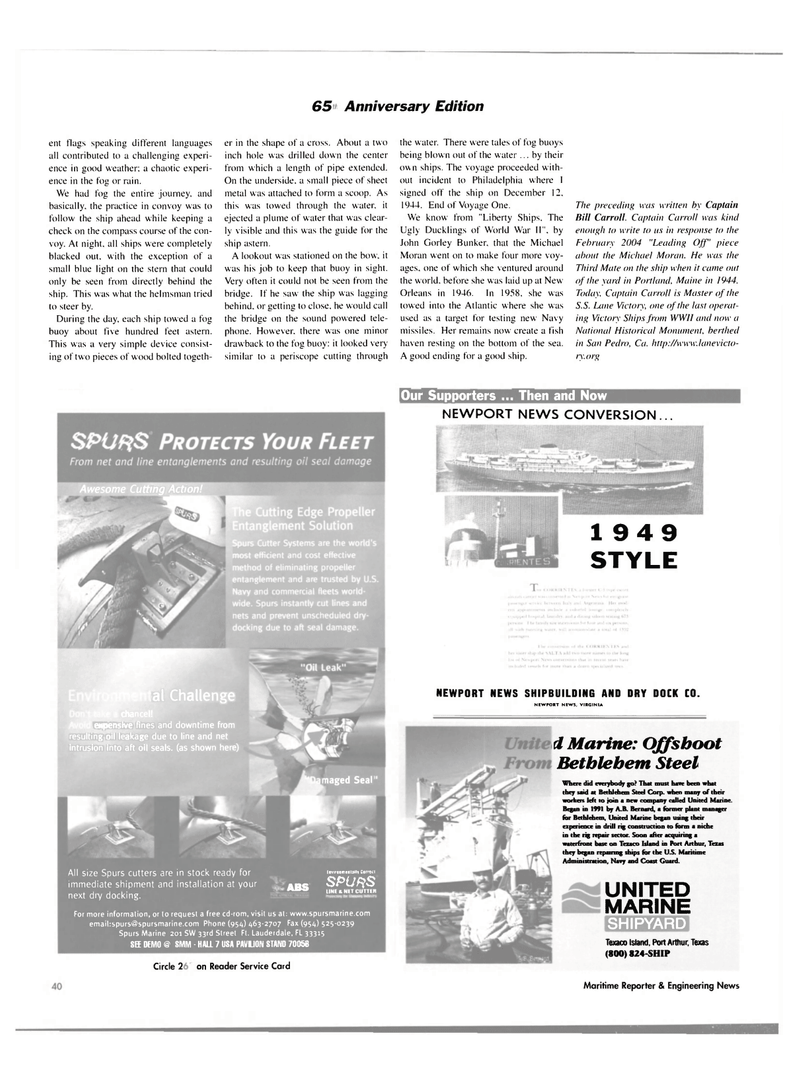
Page 38: of Maritime Reporter Magazine (August 2004)
65th Anniversary Edition
Read this page in Pdf, Flash or Html5 edition of August 2004 Maritime Reporter Magazine
65'" Anniversary Edition ent flags speaking different languages all contributed to a challenging experi- ence in good weather; a chaotic experi- ence in the fog or rain.
We had fog the entire journey, and basically, the practice in convoy was to follow the ship ahead while keeping a check on the compass course of the con- voy. At night, all ships were completely blacked out, with the exception of a small blue light on the stern that could only be seen from directly behind the ship. This was what the helmsman tried to steer by.
During the day. each ship towed a fog buoy about five hundred feet astern.
This was a very simple device consist- ing of two pieces of wood bolted togeth- er in the shape of a cross. About a two inch hole was drilled down the center from which a length of pipe extended.
On the underside, a small piece of sheet metal was attached to form a scoop. As this was towed through the water, it ejected a plume of water that was clear- ly visible and this was the guide for the ship astern.
A lookout was stationed on the bow. it was his job to keep that buoy in sight.
Very often it could not be seen from the bridge. If he saw the ship was lagging behind, or getting to close, he would call the bridge on the sound powered tele- phone. However, there was one minor drawback to the fog buoy: it looked very similar to a periscope cutting through the water. There were tales of fog buoys being blown out of the water ... by their own ships. The voyage proceeded with- out incident to Philadelphia where I signed off the ship on December 12, 1944. End of Voyage One.
We know from "Liberty Ships. The
Ugly Ducklings of World War II". by
John Gorley Bunker, that the Michael
Moran went on to make four more voy- ages. one of which she ventured around the world, before she was laid up at New
Orleans in 1946. In 1958. she was towed into the Atlantic where she was used as a target for testing new Navy missiles. Her remains now create a fish haven resting on the bottom of the sea.
A good ending for a good ship.
The preceding was written by Captain
Bill Carroll. Captain Carroll was kind enough to write to us in response to the
February 2004 "Leading Off" piece about the Michael Moran. He was the
Third Mate on the ship when it came out of the yard in Portland. Maine in 1944.
Today. Captain Carroll is Master of the
S.S. Lane Victory, one of the last operat- ing Victory Ships from WWII and now a
National Historical Monument, berthed in San Pedro, Ca. http.V/www.lanevicto- ry.org
Our Supporters ... Then and Now
Awesome Cutting Action! chancel!
SHIPYARD maged Seal
All size Spurs cutters are in stock ready for immediate shipment and installation at your next dry docking. ABS (nvtrgnmeaiJilv Corrsc!
SPURS
LINE » NET CUTTER
For more information, or to request a free cd-rom, visit us at: www.spursmarine.com email:[email protected] Phone (954) 463-2707 Fax (954) 525-0239
Spurs Marine 201 SW 33rd Street Ft. Lauderdale, FL 33315
SE DEMO @ SMM - HALL 7 USA PAVUON STAND 7005B al Challenge expensive fines and downtime from resulting oil leakage due to line and net intrusion into aft oil seals, (as shown here)
Circle 254 on Reader Service Card
NEWPORT NEWS CONVERSION...
UNITED MARINE
Texaco Island, Port Arthur, Texas (800) 824-SHIP 40 Maritime Reporter & Engineering News
NEWPORT NEWS SHIPBUILDING AND DRY DOCK CO.
NEWPORT NEWS, VIRGINIA d Marine: Offshoot
Bethlehem Steel
Where did everybody go? That must have been what they said at Bethlehem Steel Corp. when many of their workers left to join a new company called United Marine.
Began in 1991 by A.B. Bernard, a former plant manager for Bethlehem, United Marine began using their experience in drill rig construction to form a niche in the rig repair sector. Soon after acquiring a waterfront base on Texaco Island in Port Arthur, Texas they began repairing ships for the U.S. Maritime
Administration, Nary and Coast Guard. 19 4 9
STYLE

 37
37

 39
39
